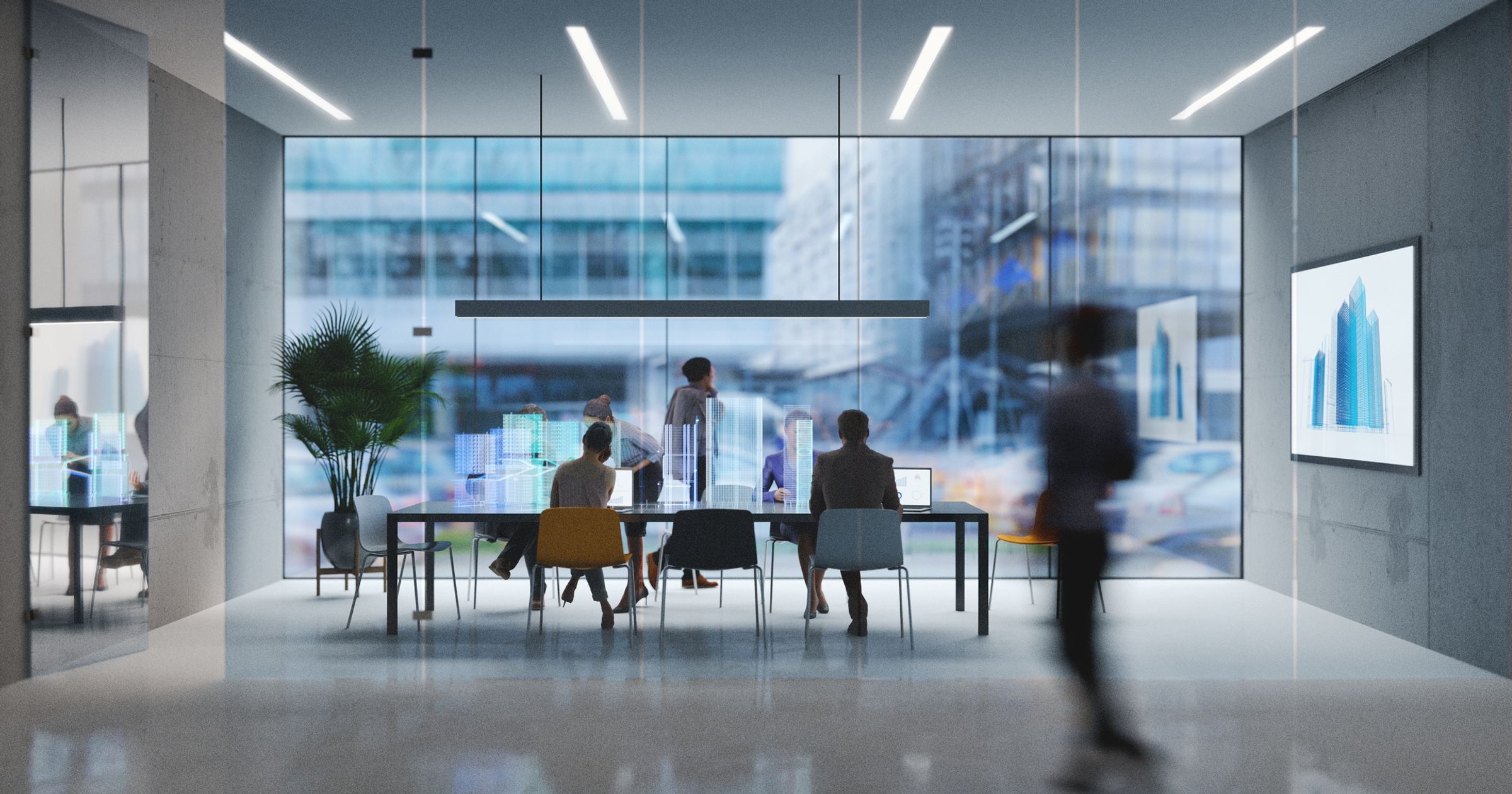I used to be born in Manhattan and lived a lot of my life within the Massive Apple. I went to high school on the Bowery and labored in workplace complexes that sat adjoining to storied locations like Wall Road, Occasions Sq., and Madison Sq. Park. I met sources for lunch and attended concert events and conferences that moved my profession ahead. However like many data staff, within the wake of the pandemic, I’ve moved away from the concrete jungle and relocated to a small, rural city just a few hours north of NYC.
I’m not alone. Current information signifies that solely 8% of workplace workers who labored in NYC pre-pandemic are again to the workplace 5 days per week. This creates a monetary disaster for main city areas. Totally 25% of NYC’s tax base every year has traditionally been derived from industrial actual property, anchored by places of work in Wall Road and Midtown and the plethora of eating places and shops and sidewalk distributors that cater to the tens of millions of people that used to move each day to and from the town’s industrial corridors. Massive cities, in different phrases, aren’t what they was once. However that leaves open a door to what cities may grow to be.
New York Metropolis’s mayor, Eric Adams, addressed the necessity for change in a current speech. “It is crucial that our financial leaders sit down and say what our enterprise facilities and districts are going to appear like,” Adams stated. “Do we alter the zoning? Will we enable these new workforce housing that is coming collectively outdoors, as a result of there’s new methods persons are doing enterprise?”
There’s something revolutionary in there. Working each day on the earth of software program builders and data administration, I believe we’re at a tipping level that can change not simply the place we work—dwelling or workplace—and the way we work—distant, async—however the nature of our cities, our cities, and with them, our civilization. From London to São Paulo, from Boston to Berlin, there is a chance for the metropolis to emerge as one thing completely different, one thing equally important, however maybe extra equitable, reasonably priced, and humane. To get this transformation proper, we are able to be taught from the world of open-source software program.
II
What drove us to work in places of work within the first place? For many of its historical past, the bodily office served important, utilitarian capabilities. DJ Huppatz and Agustin Chevez clarify that “the workplace” started as a spot the place peace and solitude would enable for focus and the place essential and uncommon works on paper may very well be safely saved:
“The origins of the trendy workplace lie with large-scale organizations corresponding to governments, buying and selling corporations and non secular orders that required written data or documentation. Medieval monks, for instance, labored in quiet areas designed particularly for sedentary actions corresponding to copying and finding out manuscripts. As depicted in Botticelli’s St Augustine in His Cell , these early ‘workstations’ comprised a desk, chair and storage cabinets.”
 Sandro Botticelli St Augustin dans son cupboard de travail or St Augustine at Work. Wikipedia Commons
Sandro Botticelli St Augustin dans son cupboard de travail or St Augustine at Work. Wikipedia Commons
Expertise performed a pivotal function within the growth of the workplace. Computer systems as soon as required whole flooring—hell, whole buildings—to accommodate their processing energy. They shrunk over time, however places of work nonetheless offered a venue for staff to entry {hardware} that was unaffordable or impractical to be used at dwelling. Huppatz and Chevez level to 1964, when IBM launched a magnetic-card recording gadget right into a Selectric typewriter , as a tipping level. From there, the performance and comfort of a small military of units—copy machines, fax machines, server racks—gave workers good causes to work from an workplace.
Even when code may very well be written at dwelling on a PC, working from dwelling as a programmer wasn’t essentially sensible. Once I spoke with Paul Ford and Sara Chipps about their early careers within the Nineties, they recalled sitting in an workplace the place variations of a software program venture have been handed round on a bodily disk. Important backups of key information and information? Typically it was just a few arduous drives in a briefcase that you just carried dwelling at evening.
As a journalist, I labored for a few years in fancy places of work that served an important perform: a hub for bodily work—collaborating on a newspaper or journal printed on ACTUAL paper—and a spot to entry a company-owned PC the place my work lived on native storage that wasn’t backed as much as any cloud.
By 2015, nevertheless, I used to be conscious about the numerous hours a day I spent commuting and the way pointless the commute was to finishing my work—how, the truth is, it usually made finishing my work more durable. By that point, my work occurred virtually solely in chat, emails, and on-line paperwork. Most desks nonetheless had a landline, however they sat unused, a relic of a special period of newsroom.
I felt on the time that seeing individuals in particular person, particularly my bosses, was key to advancing my profession. I used to be advised explicitly by my supervisor that I used to be anticipated on the workplace at the least three days per week. But there have been many days after I would arrive on the workplace and listen to no chatter across the espresso machine, see no inspiring collaboration occurring round a drafting board. Every employee, even in an open workplace plan with out cubicles, was residing utterly in their very own world: headphones on, a number of tabs open to Google Docs, Slack, Electronic mail, Spotify, Twitter, YouTube, and a dozen others. We sat or stood, our consideration fastened on the display screen, workplace banter occurring in non-public messages and throughout Twitter canoes, not within the break room.
For software program builders, the advances of the final decade, particularly the appearance of cloud computing and model management, meant that asynchronous contribution to a code base was simply as sensible from dwelling because the workplace. Pre-pandemic, nevertheless, the vast majority of giant tech corporations invested closely in actual property and dictated that workers spend at the least a number of days per week within the workplace. The transformative shock of our current quarantines and the quickly rising success of corporations based round open-source initiatives, nevertheless, is lastly catalyzing a change away from this archaic method.
III
The pandemic uncovered an unstated reality. Individuals weren’t much less productive working from dwelling; the truth is, many received extra work performed. What provides? Effectively, subtract an hour of commute every method. Subtract one other hour spent strolling to seize espresso, snacks, and lunch. Take away an hour right here or there for all of the collaboration that occurred across the ping pong desk or Xbox. Take out the stand-ups, check-ins, and conferences spent on chit-chat and obscure concepts which, ya know, might have been an e mail.
Why did so many corporations, together with supposedly forward-thinking tech corporations, insist on a heavy funding in workplace and actual property at the same time as most workplace work moved to moveable units tied to the cloud? And why are so lots of the most dear tech corporations on the earth nonetheless battling to get staff again into the workplace now?
As Huppatz and Chevez write, the workplace acts as a “seen assertion of status and energy.” Firms which have invested closely in fancy workplace parks need them bustling with worker exercise when shoppers, companions, or journalists come to go to. One other crucial for administration, normally left unsaid, is that the workplace permits them to implement monitoring, surveillance, and management. The pair write:
Varied administration theories additionally had a profound influence on the workplace. As Gideon Haigh put it in The Workplace: A Hardworking Historical past , the workplace was “an exercise lengthy earlier than it was a spot”.
Work was formed by social and cultural expectations even earlier than the trendy workplace existed. Monasteries, for instance, launched timekeeping that imposed strict self-discipline on monks’ every day routines.
Later, fashionable theorists understood the workplace as a factory-like setting. Impressed by Frank Gilbreth’s time-motion research of bricklayers and Fredrick Taylor’s Rules of Scientific Administration , William Henry Leffingwell’s 1917 ebook, Scientific Workplace Administration , depicted work as a sequence of duties that may very well be rationalized, standardized and scientifically calculated into an environment friendly manufacturing regime. Even his concessions to the workplace setting, corresponding to flowers, have been meant to extend productiveness.
For apparent causes, bodily merchandise in growth and proprietary know-how have to be safeguarded. Work on these initiatives may require an workplace or workspace separate from the house. However the overwhelming majority of code can now be written safely and securely from dwelling. The strain between workers and organizations boils all the way down to administration’s concern that over time distant staff shall be much less productive and predictable. Given what we’ve seen in the course of the pandemic, nevertheless, the onus is on leaders to indicate that working from house is much less productive earlier than insisting that working from an workplace is someway superior.
Take into consideration the worth created by merchandise like Linux and Python, Bitcoin and Ethereum, GoLang and React. Certain, individuals sat in rooms over time and labored collectively to drive these initiatives ahead. However it wasn’t the frisson of IRL interactions that turned them into the worldwide juggernauts they’re at the moment. Fairly the alternative: it was the benefit with which anybody all over the world might contribute to the venture while not having any particular permission.
Tech corporations have grow to be essentially the most beneficial organizations on earth, and the parents who write code at these corporations command, on common, the very best salaries of any career. I gained’t try to predict what the long run will maintain, however I believe it’s secure to say that coders are able to constructing extremely impactful and worthwhile instruments, platforms, and enterprise fashions with out leaving the consolation of their pajamas. More and more, staff in finance, leisure, training, and different industries are discovering methods to do the identical.
Now we have a possibility for a radical rethinking of the workplace—and the town past.
IV
Earlier than we go on, I wish to supply an apart to make one factor clear. I’m not denigrating work that doesn’t contain code or that may’t be performed remotely. The pandemic reminded us of one other essential reality—that our society can’t perform with out farmers and docs, truckers and lecturers. Whereas loads of ink has been spilled on the way forward for work, the vast majority of People, and most of the people all over the world, can’t truly do their jobs remotely. This being Stack Overflow, nevertheless, the place we serve a neighborhood of builders and technologists, it is sensible to deal with the choice of distant work and what the growth of that form of work may imply for our society. I’ll additionally acknowledge that I’m an American and the attitude right here is centered on the US. To the diploma that it’s comparable or completely different from the expertise in different locales, I might love to listen to from readers with extra data and expertise than me.
So, again to the difficulty at hand. The query we needs to be exploring isn’t how we are able to pressure individuals again into places of work to avoid wasting the outdated mannequin of a metropolis, however what cities can grow to be now that so many staff who as soon as needed to congregate there to make an influence have the choice to work remotely.What would a reimagined city heart appear like for these professions?
We all know, from a long time of analysis, that urbanization tends to exacerbate revenue inequality . In international locations like the USA, a decades-long pattern additionally noticed manufacturing transfer away from smaller cities in direction of worldwide hubs, leaving lots of of mid-sized cities and their surrounding suburbs battling city blight and rising poverty, which grew quickest in suburban areas in the course of the interval following the Monetary Disaster of 2008.
For areas outdoors the most important metropolitan areas, hybrid work has been an enormous boon. Take Troy, NY, a metropolis of fifty,000 near my new dwelling within the Hudson Valley. As The Globe and Mail reported :
For years, these small legacy cities – gutted by a loss in manufacturing, pockmarked by deserted industrial areas, and hampered by a dwindling inhabitants – have struggled to make a sustained financial restoration. But the tides could lastly be shifting. The speedy growth of hybrid and distant workplaces in the course of the pandemic, together with a local weather disaster that has underscored the vulnerability of our greater cities and laid naked the need for neighborhood resilience, has all of a sudden made locations like Troy ripe for adaptation within the twenty first century.
The well-established idea of “rewilding” urges societies to return lands again to their pure state, rebalancing environments the place vegetation and animals have been shunted apart in favor of human civilization. Hybrid and distant work present us a possibility for a re-widening, a dispersal of human capital that unwinds a few of the focus to city areas we’ve seen over the past century, restoring a greater steadiness.
Think about a world through which huge workplace districts of main cities are remade to draw residents with distant or hybrid jobs who select their dwelling based mostly not on its proximity to their company workplace, however what it affords when it comes to nice colleges, hospitals, arts, leisure, parks, waterfront, and neighborhood. Big workplace buildings might supply versatile work house that may be rented short- or long-term by people or organizations.
Changing workplace districts to live-work zones would supply a a lot wanted inflow of recent residential house, serving to to fight the rising price of properties and leases. Residents who do work important to the livelihood of a neighborhood, corresponding to lecturers, healthcare suppliers, and repair staff are supplied with tax breaks, as wanted, to make sure they’ll afford to stay alongside these whose work will be performed absolutely remotely.
Information staff like me, who transfer out of the town, make city areas extra reasonably priced for important staff who workers hospitals and eating places. In the meantime, small cities and cities that have been hollowed out by deindustrialization over the past 30 years get an inflow of recent residents to help their tax base. Once more, the vast majority of jobs don’t enable for distant work, however an excessive amount of wealth is concentrated among the many jobs that do. Empowering and even encouraging these staff to stay wherever they need might have a constructive influence on the affordability of cities and the financial well being of rural communities.
Ahead-thinking cities can nonetheless deal with attracting top-tier staff in areas like finance, know-how, and legislation, however they are going to achieve this by making themselves great locations to work, stay, and play, not by insisting on the primacy of an antiquated 9-to-5 workplace tradition.
The lesson I take from the open-source revolution and the final twenty years of software program growth is that the platforms and instruments with the least friction are likely to win out. A “butts-in-seats” mentality that calls for an everyday commute on a inflexible schedule creates a ton of pointless friction—in our jobs and in our lives. Town of the long run, I hope, shall be a spot the place anybody can safely and securely contribute their concepts or apply their expertise. Make the permissionless innovation of open supply the bedrock ideology of the following technology of city facilities, and we are able to begin to construct a brand new metropolis better-suited to our post-industrial age of data.











